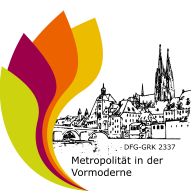
Forschungsreisen von Innocent Smith
February – Huntington Library Trip
For my dissertation project at the Universität Regensburg, I am studying medieval Bibles which contain Missals. Many of my sources are in European libraries, but a few have migrated around the world. In February 2019, I had an opportunity while visiting family in California to make a trip to the Huntington Library in San Marino, California, where an important manuscript for my research resides. San Marino, Huntington Library, HM 26061 is a 13th century Bible which contains beautiful illuminations, including a full-page crucifixion that accompanies the prayers for the Canon of the Mass. Studying the manuscript in person allowed me to develop a better understanding of the relationship of the liturgical portion of the manuscript to the broader biblical context. I was able to take many photographs of the most relevant folios of the manuscript for my research, which will allow me to continue my analysis of the textual contents and more easily compare them to the other manuscripts I am analyzing. Working at the Huntington Library was a wonderful experience; the staff members of the library were very supportive, and the idyllic setting of the surrounding gardens and art museum provided a stimulating space between sessions with the manuscript. While in the Los Angeles area, I was also able to consult an important early 13th century notated Dominican Missal at the Getty Museum, which sowed seeds for future research projects!
March Conferences in Frejus and Provins
In March 2019, I was able to participate in two manuscript studies workshops in France thanks to a travel stipend provided by the Graduiertenkolleg Metropolität in der Vormoderne. The first workshop, manuSciences ’19 in Frejus, provided an introduction to a variety of contemporary methods for manuscript study, including digital humanities, chemical and physical analyses, and imaging methods such as multi-spectral imaging. The faculty for the workshop were a diverse group of scholars from around the world who were able to effectively provide a sense of the possibilities as well as the challenges offered by these new approaches. In order to get practical experience with the machines, we each made our own “manuscripts” which we then submitted to chemical and physical analysis. I made a “fragment” of the Dominican Salve Regina chant, which yielded interesting results when examined with various instruments that could determine the different inks and pigments used on the parchment.
One important insight I gained was that the technical complexity of some of these approaches means that they are most effectively employed in collaboration between scholars with more scientific and more humanities-oriented backgrounds. The large group of students and teachers was very friendly, and we had a good balance of enjoyable social time and focused instruction. On the first day of the workshop, we had a poster session in which we took turns informally explaining our ongoing research projects to each other; I was able to present some insights from my research of medieval Bible Missals. During the poster session, I had many good conversations about the work with other participants, including specialists in Hebrew manuscripts, which provided interesting opportunities for comparison of approaches to the presentation of the biblical text. One highlight of the visit was the chance to see the ancient Cathedral of Frejus, with elements dating to the 5th century and with a beautifully preserved cloister for the medieval canons.
The following week, I participated in the “Séminaire de recherche sur les manuscrits liturgiques médiévaux de Provins”, a workshop led by Susan Boynton of Columbia University in collaboration with Luc Duchamp of Provins. During this workshop, a small group of graduate students and early career scholars had the opportunity to study the manuscripts preserved in the municipal library of Provins. I focused on three Festive Missals with musical notation that were written for use in the Canonical Church of St. Quiriace, an impressive church which dominates the landscape of the medieval city. I was privileged to have the opportunity to celebrate Mass each morning St. Quiriace, which gave my work on the medieval manuscripts a heightened interest. In addition to our time in the library, we had several interesting tours of important historical sites in the town, including the Benedictine monastic church of Saint-Ayoul and the canonical residences of St. Quiriace. At the end of the week, the participants gave presentations on their work to a group of local historians and interested residents of Provins. I gave a presentation on the three Missals I had studied, comparing their liturgical contents and singing for the audience the proper Alleluia verse contained in the three books for their patron saint, St. Quiriace.
Among the many wonderful experiences of the study week, my favorite was getting to know a local cat who lives in the neighborhood of St. Quiriace. On our first visit to the church, the cat followed us into the church and sat very patiently on a chair near our group while our tour guide explained the architecture of the church. The cat then accompanied us throughout the rest of the church, striking contemplative poses in front of the various altars. Perhaps we entertained angels unawares!

